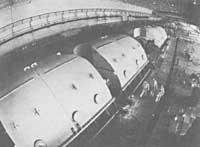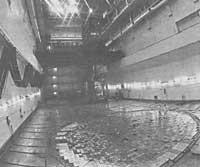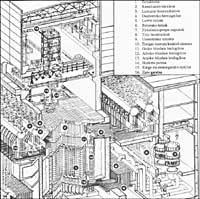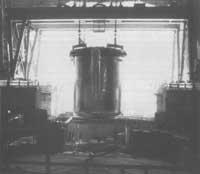Txernobil: ecology... or die?
1986/06/01 Ekhi Iturria: Elhuyar aldizkaria

In recent days the serious accident at the Chernobyl nuclear power plant in the Soviet Union has been in vogue. This has again exposed some technical, ecological, economic, political and ethical problems. That is why it is very difficult to get a seed out of these issues and not to endure the denunciations of demagogy from one place or another... because at these levels science and technology are not times of ingenious "aseptic" and "strange" sages, or "toys" of powerful authorities, but important problems that can change the ways of life of all normal people, either right or wrong.
Anyway, let's start our program by telling us the story that is being best known to us from here.
This strange atmosphere of the Soviet Union...
On 29 April, routine radioactivity measurements by Swedish technicians saw a significant increase. At first it was thought to be an accident of one of its nuclear power plants, but the hypothesis that pollution came from abroad, the Soviet Union, was ruled out.
In a reactor at the Chernobyl nuclear power plant, apparently in a nuclear fuel change, a complex failure of the cooling system caused the reaction to be out of control and, once the disfigured heating occurred, began to melt the lower part of the reactor. This caused the graphite rods used to calm the fission reaction to burn and a chemical explosion occurred. This explosion crushed the structure that protects the reactor and radioactive materials inside were thrown into the air like dust and gas. This gas created a "radioactive cloud" that has then become popular.

We must insist that the reactor explosion has been chemical and not nuclear. This is a nuclear explosion, in which the accident occurred in a power unit of 900 Megas. According to the photographs obtained through the American spy satellites (taken from 800 Km high), the radiance of the central would be 90 Rad*, a violent irradiation that no human being can withstand. For all this, the fire inside the reactor was very difficult to extinguish, although it seems that the Soviets managed to extinguish it somehow.
It will have to be said "in some way", because meteorologists consider that the atmosphere of the Soviet Union has a very special property: despite its great facility to expand radioactive particles, information can hardly cross... Thanks to this strange atmosphere, we know little about the accident of Chernobyl: photos of newspaper libraries, reports of backward journals, divisions of experts... but, in short, as long as data is not available – unfortunately – a scientific assessment cannot be made (if terrible stories have been told or semi-dignified hypotheses have been proposed, but without any scientific value).
Very long nights: Supernights
In 1978, a report published by the Spanish Atomic Forum, referring to the most serious accident a nuclear power plant could suffer, read: "...the most serious theoretical accident would be the failure fusion of the nuclear fuel cooling system included in the reactor. However, the mechanical and electronic systems of all nuclear power plants are duplicated (i.e., where a cooling water pump is needed, there are two, etc. ). Therefore, if one of them failed, the other would start working automatically. In addition, surrounding the entire reactor is the protective bell, which would maintain the possible gas leak in the accident. Therefore, the probability of the death of a person for this cause would be 0.2 million years in each plant..."
Americans call this type of accident "super-nights" (name I actually celebrate; even if it is English, the "exotic" Basque air) and for it to occur for years it is necessary to overcome a critical mass of fission fuel, but also the system must have a special geometry. In the design of the reactors of all nuclear power plants, logically, systems are made that make this geometry impossible, thus avoiding the reaction of nuclear fission chains.
The Chernobyl nuclear power plant consists of four RBMK-1000 reactors, one of which has been repeated several times:
Fortunately, in all these cases, reactors were surrounded by forced protective bells, unlike Chernobyl, and accidents were not so severe (at least in apparent damage to humans).
Unfortunately, the relatives of the two workers who have officially died in Chernobyl and two hundred other workers who are contaminated by radioactivity, if they live, will perfectly remember the long "super-night" after the accident...
- 1.957. Windscale (Great Britain). In a nuclear plutonium production plant the graphite poles were burned and the uranium melted, extending the radioactive substances to the atmosphere. In a 60MW rapid neutron reactor called Long Beach (USA) "Enrico Fermi" partially melted uranium, totally contaminating the inside of the plant.1.969. Saint Laurent des Eaux (France). The carbon dioxide cooled reactor began to melt, contaminating 24 workers. 1979. At the "Three Mile Island" plant in Harrisburg, USA, a hydrogen bubble prevented proper cooling of the reactor and uranium was partially melted.

Gai honi buruzko eduki gehiago
Elhuyarrek garatutako teknologia






